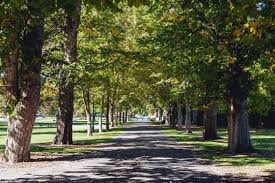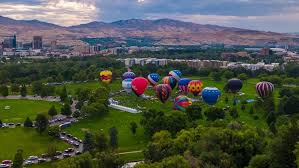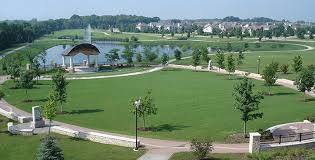The Treasure Valley’s identity is intrinsically linked to its beautiful green spaces. From the bustling hub of Downtown Boise to the sprawling suburban recreation areas, our parks are more than just lawns and trails—they are living museums, honoring our pioneers, philanthropists, and natural landscape.
Here at Totally Boise, we’re taking a historic stroll to uncover the surprising origins and fascinating facts behind some of the Valley's most cherished parks.
Boise’s “Ribbon of Jewels”: Parks Named for Pioneers
The collection of parks that run along the Boise River Greenbelt is affectionately known as the "Ribbon of Jewels," most of which were named to honor prominent local women.
Julia Davis Park: The Oldest Jewel
-
The Origin: Julia Davis Park is the oldest park in the City of Boise, established in 1907 when Thomas Jefferson Davis donated 40 acres of his former orchard land to the city as a memorial to his beloved late wife, Julia.
-
A Historic Hub: More than a park, Julia Davis is the cultural heart of the city, housing the Boise Art Museum, Zoo Boise, the Idaho State Historical Museum, and the Discovery Center of Idaho. Its rose garden, which was officially dedicated in 1939, originated with a men's garden club called the "Cut Worms"—whose rules included "no women and no publicity!"

Ann Morrison Park: A Gift of Love
-
The Namesake: Ann Morrison Park is named for Ann Daly Morrison, the beloved wife of construction magnate Harry W. Morrison, the founder of the massive Morrison-Knudsen Company. After Ann's death, Harry purchased the land and oversaw the park’s construction in her honor, donating the finished park to the City of Boise in 1959. Ann was known as a deeply engaged citizen dedicated to the city's prosperity.
-
Construction Power: The park was actually built by employees of the Morrison-Knudsen Company, ensuring its high quality and quick realization as a community asset.

Kathryn Albertson Park: A Natural Sanctuary
-
When It Was Made a Park: Kathryn Albertson Park was formally dedicated on October 17, 1989, which was also the 84th birthday of her husband, Joe Albertson (founder of Albertsons grocery stores).
-
The Vision: Joe and Kathryn Albertson donated the land to the city with the vision of transforming a dusty horse pasture into a meticulously designed sanctuary for both migratory and resident wildlife. The 41-acre park is famous for its peaceful, manicured paths, bridges, and intimate gazebos designed for quiet contemplation.
Esther Simplot Park: From Concrete to Canoe
-
The Transformation: Esther Simplot Park, named for the local performing arts advocate and widow of J.R. Simplot, is a modern success story in conservation. In 2003, Esther and J.R. Simplot donated $1 million to the city, allowing Boise Parks & Recreation to purchase former gravel and concrete plant property along the river.
-
Modern Gem: Dedicated in 2016, the 55-acre park features over 23 acres of interconnected ponds, creating a major recreation area for paddle boarding, swimming, and fishing.
The North End & Suburbs: Community Cornerstones
Beyond the Ribbon of Jewels, other historic and significant parks anchor Treasure Valley neighborhoods.
Camel's Back Park (Boise)
-
The Hump’s History: The park site, including its iconic sandy hump, was acquired by the City of Boise in 1932 from Bernard Lemp, a relative of a former mayor.
-
Community Effort: While acquired in the 30s, the park was heavily developed through community and organization donations—including the National Guard and various clubs—and was officially dedicated in 1965. Today, it remains the cherished gateway to the Boise Foothills trail system.

C.W. Moore Park: The First Playground?
-
Early History: C.W. Moore deeded his two lots to the city in 1916 for the express purpose of creating a children's park.
-
First Playground: While Julia Davis Park had a general development plan in 1912, C.W. Moore’s donation specified its use as a children's park and playground. The playground was finally constructed in the 1930s, making it one of the earliest official playgrounds in the city park system.
Settlers Park (Meridian)
-
A Modern Regional Hub: Settlers Park, located at Meridian and Ustick Roads, is a relatively modern regional park that was built in phases between 2003 and 2014.
-
Irrigation Legacy: The park's name indirectly acknowledges the region's agricultural history, referencing the Settlers Ditch Company, an irrigation system established by early farmers in the 1880s that was essential for Meridian's growth. The land itself is dedicated to massive athletic and recreation amenities.

Julius M. Kleiner Memorial Park (Meridian)
-
A Farm's Transformation: Kleiner Park is another gift to the community, built on farmland donated by the family of Julius M. Kleiner.
-
Features: Established in 2012, the park is marked by unique features like a statue of Mr. Kleiner, a Rock of Honor memorial for veterans, and obelisks that incorporate recycled railroad supports taken from the farm, memorializing the land's previous life.

The next time you enjoy a stroll, a picnic, or a round of pickleball, take a moment to appreciate the enduring gifts and the rich history that built the Treasure Valley’s incredible park system!